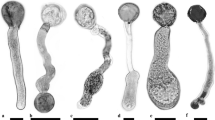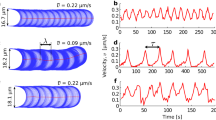Abstract
The shape of the apical region of lily pollen tube changes rhythmically as the growth rate of the tube oscillates becoming alternately more prolate then back to oblate. We quantified shape change by calculating the curvature of the cross-sectional edge of the pollen tube tip and cross-correlating curvature changes with growth rate. The apical region takes the form of a partial elliptical spheroid, with variation in the length and location of the minor axis. During oscillation curvature profiles show a sharp increase in curvature at the “shoulders” of the apex when oblate, 4–7 μm from the flatter central zone. As the tip becomes more prolate, the “shoulders” decrease rapidly in curvature and move towards the growth axis as curvature at the tip increases. We understand curvature changes to represent differential changes in local wall expansion rates, driven by uniform turgor pressure and mediated by changes in wall polysaccharides. To become more oblate, the tip region must become less extensible than the “shoulder” region. And, as the tip becomes more prolate, the increased curvature must be due to increased local expansion. We found that changes in the growth velocity of the “shoulders” of the cell measured as the progress of the cell edge along the growth axis are cyclically out of phase with growth velocity at the tip such that the shoulder regions lag for part of the oscillation cycle, then “catch up” as the growth rate at the tip reaches a maximum and begins to decline. In this way the cell becomes oblate. Cell shape and growth rate oscillate in concert and are functionally related. Spatial change in edge growth rate points to important cellular locations for further investigation of vesicle movement and exocytosis, calcium gradients, and actin dynamics in lily pollen tubes.










Similar content being viewed by others
Data availability
All data and images are available on request to the corresponding author.
Code availability
R scripts used during image and data analysis are available from the corresponding author.
References
Benkert R, Obermeyer G, Bentrup FW (1997) The turgor pressure of growing lily pollen tubes. Protoplasma 198:1–8. https://doi.org/10.1007/BF01282125
Bidhendi AJ, Geitmann A (2018) Finite element modeling of shape changes in plant cells. Plant Physiol 176:41–56. https://doi.org/10.1104/pp.17.01684
Bosch M, Hepler PK (2005) Pectin methylesterases and pectin dynamics in pollen tubes. Plant Cell 17:3219–3226. https://doi.org/10.1105/tpc.105.037473
Cameron C, Geitmann A (2018) Cell mechanics of pollen tube growth. Curr Opin Genet Devel 51:11–17. https://doi.org/10.1016/j.gde.2018.03.008
Campanoni P, Blatt MR (2007) Membrane trafficking and polar growth in root hairs and pollen tubes. J Exp Bot 58:65–74. https://doi.org/10.1093/jxb/erl059
Campàs O, Mahadevan L (2009) Shape and dynamics of tip-growing cells. Curr Bio 19:2102–2107. https://doi.org/10.1016/j.cub.2009.10.075
Cárdenas L, Lovy-Wheeler A, Kunkel JG, Hepler PK (2008) Pollen tube growth oscillations and intracellular calcium levels are reversibly modulated by actin polymerization. Plant Physiol 146:1611–1621. https://doi.org/10.1104/pp.107.113035
Chebli Y, Geitmann A (2007) Mechanical principles governing pollen tube growth. Floricult Ornamen Biotech 1:232–245
Cole RA, Fowler JE (2006) Polarized growth: maintaining focus on the tip. Curr Opin Plant Biol 9:579–588. https://doi.org/10.1016/j.pbi.2006.09.014
Cosgrove DJ (2000) Loosening of plant cell walls by expansins. Nature 407:321–326. https://doi.org/10.1038/35030000
Dumais J, Shaw SL, Steele CR, Long SR, Ray PM (2006) An anisotropic-viscoplastic model of plant cell morphogenesis by tip growth. Int J Dev Biol 50:209–222. https://doi.org/10.1387/ijdb.052066jd
Edelstein AD, Tsuchida MA, Amodaj N, Pinkard H, Vale RD, Stuurman N (2014) Advanced methods of microscope control using μManager software. J Biol Meth 1(2):e10. https://doi.org/10.14440/jbm.2014.36
Fayant P, Girlanda O, Chebli Y, Aubin CE, Villemure I, Geitmann A (2010) Finite element model of polar growth in pollen tubes. Plant Cell 22:2579–2593. https://doi.org/10.1105/tpc.110.075754
Feijó JA, Sainhas J, Holdaway-Clarke T, Cordeiro MS, Kunkel JG, Hepler PK (2001) Cellular oscillations and the regulation of growth: the pollen tube paradigm. BioEssays 23:86–94. https://doi.org/10.1002/1521-1878(200101)23:1%3c86::AID-BIES1011%3e3.0.CO;2-D
Green PB, King A (1966) A mechanism for the origin of specifically orientated texture in development with special reference to Nitella wall texture. Aust J Biol Sci 19:421–437. https://doi.org/10.1071/BI9660421
Hepler PK, Rounds CM, Winship LJ (2013) Control of cell wall extensibility during pollen tube growth. Molec Plant 6:998–1017. https://doi.org/10.1093/mp/sst103
Holdaway-Clarke TL, Hepler PK (2003) Control of pollen tube growth: role of ion gradients and fluxes. New Phytol 159:539–563. https://doi.org/10.1046/j.1469-8137.2003.00847.x
Krichevsky A, Kozlovsky SV, Tian GW, Chen MH, Zaltsman A, Citovsky V (2007) How pollen tubes grow. Devel Biol 303:405–420. https://doi.org/10.1016/j.ydbio.2006.12.003
Kroeger JH, Geitmann A (2012) The pollen tube paradigm revisited. Curr Opin Plant Biol 15:618–624. https://doi.org/10.1016/j.pbi.2012.09.007
Kroeger JH, Bou Daher F, Grant M, Geitmann A (2009) Microfilament orientation constrains vesicle flow and spatial distribution in growing pollen tubes. Biophys J 97:1822–1831. https://doi.org/10.1016/j.bpj.2009.07.038
Lovy-Wheeler A, Kunkel JG, Allwood EG, Hussey PJ, Hepler PK (2006) Oscillatory increases in alkalinity anticipate growth and may regulate actin dynamics in pollen tubes of lily. Plant Cell 18:2182–2193. https://doi.org/10.1105/tpc.106.044867
McKenna ST, Kunkel JG, Bosch M, Rounds CM, Vidali L, Winship LJ, Hepler PK (2009) Exocytosis precedes and predicts the increase in growth in oscillating pollen tubes. Plant Cell 21:3026–3040. https://doi.org/10.1105/tpc.109.069260
Parre E, Geitmann A (2005) Pectin and the role of the physical properties of the cell wall in pollen tube growth of Solanum chacoense. Planta 220:582–592. https://doi.org/10.1007/s00425-004-1368-5
R Core Team (2020). R: A language and environment for statistical computing. R Foundation for Statistical Computing, Vienna, Austria. https://www.R-project.org/. Accessed 10 Oct 2020
Reimann R, Kah D, Mark C, Dettmer J, Reimann TM, Gerum RC, Geitmann A, Fabry B, Dietrich P, Kost B (2020) Durotropic growth of pollen tubes. Plant Physiol 183:55–569. https://doi.org/10.1104/pp.19.01505
Rojas ER, Hotton S, Dumais J (2011) Chemically mediated mechanical expansion of the pollen tube cell wall. Biophys J 101:1844–1853. https://doi.org/10.1016/j.bpj.2011.08.016
Rounds CM, Winship LJ (2011) Hepler, PK (2011) Pollen tube energetics: respiration, fermentation and the race to the ovule. AoB PLANTS 1:plr019. https://doi.org/10.1093/aobpla/plr019
Schindelin J, Arganda-Carreras I, Frise E et al (2012) Fiji: an open-source platform for biological-image analysis. Nat Methods 9(7):676–682. https://doi.org/10.1038/nmeth.2019
Trinci APJ, Saunders PT (1977) Tip growth of fungal hyphae. J Gen Micro 107:243–248. https://doi.org/10.1099/00221287-103-2-243
Van Hemelryck M, Bernal R, Ispolatov Y, Dumais J (2018) Lily pollen tubes pulse according to a simple spatial oscillator. Sci Rep 8:12135. https://doi.org/10.1038/s41598-018-30635-y
Winship LJ, Obermeyer G, Geitmann A, Hepler PK (2010) Under pressure, cell walls set the pace. Trends Plant Sci 15:363–369. https://doi.org/10.1016/j.tplants.2010.04.005
Zerzour R, Kroeger J, Geitmann A (2009) Polar growth in pollen tubes is associated with spatially confined dynamic changes in cell mechanical properties. Dev Biol 334:437–446. https://doi.org/10.1016/j.ydbio.2009.07.044
Funding
This work was supported by the research grant MCB-0847876, from the National Science Foundation to PKH and by funds from the University of Massachusetts Research Trust Fund also to PKH.
Author information
Authors and Affiliations
Contributions
All authors contributed to the study conception and design. Material preparation, data collection, and analysis were performed by Grace Rosen and Lawrence Winship. The first draft of the manuscript was written by Grace Rosen as her senior thesis at Hampshire College, and all authors commented on previous versions of the manuscript. Peter Hepler and Lawrence Winship edited, read, and approved the final manuscript.
Corresponding author
Ethics declarations
Conflict of interest
The authors declare no competing interests.
Additional information
Handling Editor: Andreas Holzinger.
Publisher's note
Springer Nature remains neutral with regard to jurisdictional claims in published maps and institutional affiliations.
This manuscript is an invited submission to a special issue entitled “Ultrastructure of Plant Cells,” edited by Andreas Holzinger, dedicated as a memorial to Dr. Ursula Lütz-Meindl.
Rights and permissions
About this article
Cite this article
Winship, L.J., Rosen, G.A. & Hepler, P.K. Apical pollen tube wall curvature correlates with growth and indicates localized changes in the yielding of the cell wall. Protoplasma 258, 1347–1358 (2021). https://doi.org/10.1007/s00709-021-01694-2
Received:
Accepted:
Published:
Issue Date:
DOI: https://doi.org/10.1007/s00709-021-01694-2




